Summary of Findings
 With three months to go until the presidential election, the American public remains largely dissatisfied with economic conditions and with President Bush’s stewardship of the economy. Two-thirds rate the national economy as “only fair” or “poor,” while just one-third judge it to be “excellent” or “good.” Accordingly, Bush gets low ratings for his handling of the economy: 42% approve, 52% disapprove. And by an increasing margin, voters express more confidence in the Democratic nominee, John Kerry, than in Bush to improve economic conditions. Kerry now leads Bush by a wide 52% to 37% margin on the economy, up from a 44% to 39% lead in March.
With three months to go until the presidential election, the American public remains largely dissatisfied with economic conditions and with President Bush’s stewardship of the economy. Two-thirds rate the national economy as “only fair” or “poor,” while just one-third judge it to be “excellent” or “good.” Accordingly, Bush gets low ratings for his handling of the economy: 42% approve, 52% disapprove. And by an increasing margin, voters express more confidence in the Democratic nominee, John Kerry, than in Bush to improve economic conditions. Kerry now leads Bush by a wide 52% to 37% margin on the economy, up from a 44% to 39% lead in March.
While public attitudes toward the economy loom as a major problem for the president, there are also some indications in the latest Pew Research Center nationwide survey, conducted August 5-10 among 1,512 adults (1,166 registered voters), of a slight improvement in economic attitudes. The number of Americans who expect that their personal financial situation will improve has risen to 70%, up from 64% in September 2003.
And despite news that employers added fewer jobs than expected in July, Americans are slightly more positive about the job market in their local communities than they had been. Currently 34% report that jobs are plentiful in their community. This is the best evaluation of the local job conditions in Pew surveys since June of 2001, and it is better than the 27% who had a positive opinion of the job situation at the start of this year. Even so, a 55% majority continue to say that jobs are difficult to find in their communities. This compares to only 44% who held that view early in Bush’s term (June of 2001).
Overall, people are more positive about their own personal financial situation than about the national economy: 51% say they are in excellent or good shape, while 48% say they are in only fair or poor shape. Four years ago at this time the public had about the same take on their personal financial situation (52% positive, 46% negative), but they were more positive eight years ago (55%-44%), and much more negative in the summer of 1992 (35%-64%). Swing voters are more bearish about the nation’s economic prospects than voters who say they have already decided on a presidential candidate.
 Coming out of last month’s Democratic convention, there is a widening disparity in how the voters see the two major candidates. The president has the advantage on most character assessments while his challenger is favored on most issues.
Coming out of last month’s Democratic convention, there is a widening disparity in how the voters see the two major candidates. The president has the advantage on most character assessments while his challenger is favored on most issues.
In fact, Kerry’s issue advantage over Bush has improved slightly since May. The Democratic challenger now holds a bigger margin on all key domestic issues including the economy, health care and education. He also has made gains with respect to Iraq. The public now has about equal levels of confidence in the two candidates to make wise decisions about what to do there. President Bush’s sole clear issue advantage over Senator Kerry is on defending the country from terrorist attack. But it has narrowed to a 49% to 39% margin for Bush, down from a 52% – 33% margin in May.
While Kerry tests better on most issues now than he did in late spring, Bush has widened his margin over his opponent during this same period on the question of who is a “strong leader.” Bush now holds a 57%-34% edge over Kerry on this measure, up slightly from a 50% to 31% margin that the president enjoyed in May. Bush is also given the advantage over his Democratic rival for using “good judgment in a crisis” and for being “willing to take a stand, even if unpopular.” More Americans now than before the convention view Kerry as someone who “changes his mind too much.” Bush is seen as the more “stubborn” candidate, but he is also seen as the more “down to earth” person, and the number describing Bush as the more “honest and truthful” candidate has risen to 42%, up from 34% in May.
 With Bush holding the advantage on most personal qualities and Kerry on most issues, the horse race itself is about as deadlocked as it was prior to the Democratic Convention, with 47% of registered voters favoring the Kerry/Edwards ticket, and 45% favoring Bush and Cheney. Just 2% say they would vote for Nader if the election were being held today. Follow-up questions indicate that most of Kerry’s supporters are still mainly motivated by being anti-Bush (51%) rather than pro-Kerry (43%). However, the current pro-Kerry component of the Democrat’s vote base has risen sharply since May, when it was just 29%, while the anti-Bush component has dropped from 64%. A majority (59%) of the Democratic candidate’s backers now say they support him strongly, though a larger majority (71%) of Bush’s backers say they support him strongly. Bush supporters, by a margin of nearly four-to-one, describe their vote as being mainly pro-Bush rather than anti-Kerry.
With Bush holding the advantage on most personal qualities and Kerry on most issues, the horse race itself is about as deadlocked as it was prior to the Democratic Convention, with 47% of registered voters favoring the Kerry/Edwards ticket, and 45% favoring Bush and Cheney. Just 2% say they would vote for Nader if the election were being held today. Follow-up questions indicate that most of Kerry’s supporters are still mainly motivated by being anti-Bush (51%) rather than pro-Kerry (43%). However, the current pro-Kerry component of the Democrat’s vote base has risen sharply since May, when it was just 29%, while the anti-Bush component has dropped from 64%. A majority (59%) of the Democratic candidate’s backers now say they support him strongly, though a larger majority (71%) of Bush’s backers say they support him strongly. Bush supporters, by a margin of nearly four-to-one, describe their vote as being mainly pro-Bush rather than anti-Kerry.
The potential swing vote remains smaller than usual. Roughly one-in-five voters (22%) are either undecided, or favor a candidate but say they still might change their minds. This is virtually unchanged from May and June, and represents far fewer swing voters than there were at the same stage in the three previous election cycles.
 The presidential candidates are judged as about equally likable, and favorability ratings for both men have risen since June. However, Democratic vice presidential candidate John Edwards gets a more positive rating (58% favorable to 24% unfavorable) than either Bush or Kerry, while Vice President Dick Cheney gets markedly lower ratings (47% to 41%). Since Cheney took office in 2001, the percentage of Americans who rate him favorably has dropped 15 points and the percentage who rate him unfavorably has risen 23 points. But the public is even more negative toward independent candidate Ralph Nader: his unfavorable ratings are now almost twice the size of his favorables. At this stage of Nader’s 2000 campaign for president, public opinion about him was just the opposite; his favorable ratings were roughly twice as large his unfavorable evaluations.
The presidential candidates are judged as about equally likable, and favorability ratings for both men have risen since June. However, Democratic vice presidential candidate John Edwards gets a more positive rating (58% favorable to 24% unfavorable) than either Bush or Kerry, while Vice President Dick Cheney gets markedly lower ratings (47% to 41%). Since Cheney took office in 2001, the percentage of Americans who rate him favorably has dropped 15 points and the percentage who rate him unfavorably has risen 23 points. But the public is even more negative toward independent candidate Ralph Nader: his unfavorable ratings are now almost twice the size of his favorables. At this stage of Nader’s 2000 campaign for president, public opinion about him was just the opposite; his favorable ratings were roughly twice as large his unfavorable evaluations.
First Lady Laura Bush continues to be highly popular with the American public 70% judge her favorably. Even most Democrats (53%) say they like the first lady. By comparison, initial reactions to Teresa Heinz Kerry are less favorable 43% of respondents say they have a positive view of the Democratic candidate’s spouse, while 30% rate her unfavorably. More than a quarter (27%) either haven’t heard of her or don’t feel that they can express an opinion. In a pattern reminiscent of the public’s early responses to First Lady Hillary Clinton, men hold significantly less favorable views of Mrs. Heinz Kerry than do women.
The poll, which was conducted after the elevation of the terrorism threat level to Code Orange in the New York, New Jersey and Washington, DC financial districts, finds no significant increase in terrorism worries. Relatively few (28%) say they are concerned that the government is issuing too many false alarms about terrorism; instead, two-thirds say the government should give the public all the warnings it can. When asked if the recent terror alert was raised mostly for political purposes or mostly as a genuine warning to the public, 34% said the former, 57% the latter.
For Swing Voters, Economy Hasn’t Turned the Corner
Twice as many Americans rate the nation’s economy as only fair or poor (66%) as rate it excellent or good (33%). In April, 38% gave the economy positive marks, while 60% rated it negatively. Currently, 36% of Americans express a positive outlook that things will be better a year from now, a 47% plurality think things will be about the same, and 9% think the economy is headed in the wrong direction.
 While the president’s committed backers give the economy generally favorable ratings and are optimistic that things will get even better, swing voters are not of the same mind. By a 66% to 34% margin, swing voters rate the current economy as only fair or poor, and barely a quarter of swing voters (27%) think the economy is headed in a positive direction over the coming year. In fact, swing voters are slightly less optimistic about the nation’s economic prospects than are committed Kerry backers, 32% of whom think the economy will improve. (Most Kerry supporters also think he will win in November, and this expectation may be a factor in their optimism about the economy.)
While the president’s committed backers give the economy generally favorable ratings and are optimistic that things will get even better, swing voters are not of the same mind. By a 66% to 34% margin, swing voters rate the current economy as only fair or poor, and barely a quarter of swing voters (27%) think the economy is headed in a positive direction over the coming year. In fact, swing voters are slightly less optimistic about the nation’s economic prospects than are committed Kerry backers, 32% of whom think the economy will improve. (Most Kerry supporters also think he will win in November, and this expectation may be a factor in their optimism about the economy.)
Evaluations of the jobs situation are still negative, as they have been all year, but they have improved somewhat. A third (34%) of Americans now say that plenty of jobs are available in their community, while 55% say jobs are difficult to find. As recently as January, six-in-ten said jobs were difficult to find, while only 27% said plenty were available.
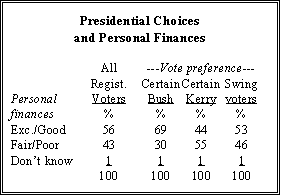 This improvement comes across the socio-economic spectrum, though there remains a sizable gap between wealthier and poorer Americans in their assessments about the availability of jobs. Today, 46% of people with annual household incomes over $75,000 say plenty of jobs are available, while only 23% of those earning less than $30,000 a year share this upbeat assessment. The already sizable gap between Democrats and Republicans on this question has only widened. Today, just 17% of Democrats say jobs are plentiful in their area, unchanged from earlier in the year. On the other hand, a majority of Republicans (54%) say plenty of jobs are available, up from 40% in January. More independents see jobs as plentiful today than in January (35%, up from 25%), but a majority of independents (56%) continue to say that jobs are difficult to find in their area.
This improvement comes across the socio-economic spectrum, though there remains a sizable gap between wealthier and poorer Americans in their assessments about the availability of jobs. Today, 46% of people with annual household incomes over $75,000 say plenty of jobs are available, while only 23% of those earning less than $30,000 a year share this upbeat assessment. The already sizable gap between Democrats and Republicans on this question has only widened. Today, just 17% of Democrats say jobs are plentiful in their area, unchanged from earlier in the year. On the other hand, a majority of Republicans (54%) say plenty of jobs are available, up from 40% in January. More independents see jobs as plentiful today than in January (35%, up from 25%), but a majority of independents (56%) continue to say that jobs are difficult to find in their area.
 While most Americans are optimistic about their own personal economic prospects even when times are tough, the proportion who expect their financial situation to improve in the coming year has risen to 70%; a year ago 64% held this view. The public remains divided over whether they are currently doing well financially 51% describe their financial situation as excellent or good, 48% as only fair or poor. Just over half of swing voters (53%) rate their financial situation favorably, while 46% do not.
While most Americans are optimistic about their own personal economic prospects even when times are tough, the proportion who expect their financial situation to improve in the coming year has risen to 70%; a year ago 64% held this view. The public remains divided over whether they are currently doing well financially 51% describe their financial situation as excellent or good, 48% as only fair or poor. Just over half of swing voters (53%) rate their financial situation favorably, while 46% do not.
No Convention Bounce for Kerry
While the Democratic Convention improved John Kerry’s visibility and gave more supporters reasons to vote for him rather than just against George W. Bush, it did not help his standing in the head-to-head electoral trial heat. Currently, 47% of registered voters favor Kerry, 45% favor Bush, figures which are virtually unchanged from July (46% Kerry, 44% Bush). Support for Ralph Nader’s candidacy has eroded, dropping from 6% in June to 3% in July to 2% now.
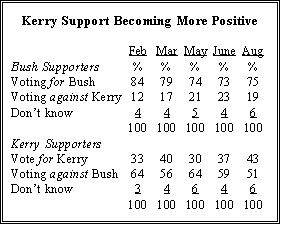 The political landscape has remained stable over the past few months. Kerry continues to run stronger among women, people under age 30, blacks and Hispanics. Bush still finds more backing from men, people age 30-49, and white evangelical Protestants, who favor the president by 71% to 23%. By comparison, white mainline Protestants and white Catholics split their support between the candidates, while seculars (those who report no religious affiliation) favor Kerry by a 67% to 23% margin.
The political landscape has remained stable over the past few months. Kerry continues to run stronger among women, people under age 30, blacks and Hispanics. Bush still finds more backing from men, people age 30-49, and white evangelical Protestants, who favor the president by 71% to 23%. By comparison, white mainline Protestants and white Catholics split their support between the candidates, while seculars (those who report no religious affiliation) favor Kerry by a 67% to 23% margin.
The Democratic Convention increased the public’s familiarity with John Kerry’s and fortified his support. Throughout the spring, and still today, a majority of Kerry backers said their choice was mostly a vote against George W. Bush. But the combination of the convention, the addition of Edwards to the ticket, and the Democratic candidate’s growing media exposure has substantially increased his positive support. Today, 43% of Kerry’s supporters characterize their choice as a vote for Kerry, up from 37% in June and just 30% in May.
 Even so, more than half of Kerry’s backers (51%) continue to describe their choice as mostly anti-Bush. By comparison, only 19% of Bush supporters describe their vote as against John Kerry, while three-quarters say their choice is motivated by support for Bush.
Even so, more than half of Kerry’s backers (51%) continue to describe their choice as mostly anti-Bush. By comparison, only 19% of Bush supporters describe their vote as against John Kerry, while three-quarters say their choice is motivated by support for Bush.
Nearly a quarter of registered voters (23%) say they feel they know “a lot” about John Kerry and what he stands for, up from just 15% in a June NBC/Wall Street Journal survey. Nearly four-in-ten (39%) of voters who followed the convention very closely say they know a lot about the Democratic nominee, compared with just 23% of those who did not follow as closely.
‘Strong’ Support for Bush
Bush still garners significantly more intense positive support than does Kerry. Currently, 71% of Bush backers say they “strongly” support the president’s reelection. By comparison, just 59% of Kerry backers say they strongly support his candidacy.
While Bush garners more affirmative backing, the strong anti-Bush sentiment among many Democrats results in both sides expressing equally high levels of commitment to their choices.
 Fully 83% of Bush supporters say they have definitely decided not to vote for Kerry, while 84% of Kerry supporters say the same about the president. Both figures are higher than in 2000, when roughly three-quarters of Bush and Gore supporters (77% and 75%, respectively) expressed this level of commitment at a similar point in the campaign.
Fully 83% of Bush supporters say they have definitely decided not to vote for Kerry, while 84% of Kerry supporters say the same about the president. Both figures are higher than in 2000, when roughly three-quarters of Bush and Gore supporters (77% and 75%, respectively) expressed this level of commitment at a similar point in the campaign.
As a result, there are fewer swing voters in this year’s election cycle. Barely one-in-five voters today (22%) are undecided or say there is a chance they will still change their minds. As late as September of 2000, fully a third of voters were still uncommitted. This year, the number of swing voters declined from 29% in February to 22% in May. It has remained at about that level since then.
There is little indication that either campaign has more effectively mobilized its base of support at this point in the campaign. Roughly nine-in-ten registered voters who back both Bush (92%) and Kerry (88%) say they are “absolutely certain” that they will vote this fall.
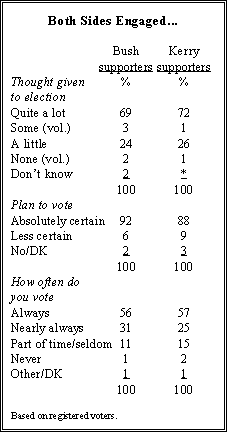 Overall, 69% of voters say they have given “quite a lot” of thought to the election already, and this level of attentiveness is equally high on both sides of the partisan divide. In addition, 56% of Bush supporters and 57% of Kerry supporters say that they “always vote.”
Overall, 69% of voters say they have given “quite a lot” of thought to the election already, and this level of attentiveness is equally high on both sides of the partisan divide. In addition, 56% of Bush supporters and 57% of Kerry supporters say that they “always vote.”
Public attention to the 2004 presidential campaign continues to run ahead of where it was at the same stage of the 2000 and 1996 campaigns. Nearly a third of Americans (32%) say they are following news about the candidates very closely, compared with 22% and 24% in September 2000 and 1996. And 69% of voters say they have given quite a lot of thought to the campaign significantly more than in 2000 or 1996 (59% and 56%, respectively). Both measures are on par with voter engagement in August of the 1992 election.
Who will win?
By a 44% to 37% margin, more voters believe that Bush will win November. Not surprisingly, there is a stark partisan division on this question. By a 76% to 7% margin, the president’s supporters are optimistic that their man will win reelection. Most Kerry supporters are also optimistic about their candidate’s chances, though by a somewhat smaller margin (67% say Kerry will win; 15% say Bush will win).
While more think Bush will win the election, this expectations advantage comes mostly from people who have not been following the campaign. By a two-to-one margin (54% to 26%), voters who say they have not followed the campaign closely at all believe that Bush will emerge victorious.
 By comparison, voters who are following the race very closely are divided evenly over who will win, with 44% placing their bets on Kerry and 43% predicting Bush.
By comparison, voters who are following the race very closely are divided evenly over who will win, with 44% placing their bets on Kerry and 43% predicting Bush.
Kerry Strong on Issues
John Kerry continues to hold a sizable lead over the president as the candidate best able to handle most domestic issues, and has made considerable gains in terms of foreign and security issues as well. But Bush maintains a clear advantage as the candidate with better leadership qualities in the eyes of most voters, and Kerry has not shaken the impression that he changes his mind too much.
Kerry continues to dominate on traditional Democratic issues such as education, health care and jobs, and has built a substantial lead as the candidate who will improve the economy (52% say Kerry can do the better job, 37% Bush). Kerry’s advantage on each of these issues has widened slightly since May, with majorities picking him over Bush on all four issues. The largest gap is over who can best improve the health care system with 55% saying Kerry could better handle this and only 29% picking Bush.
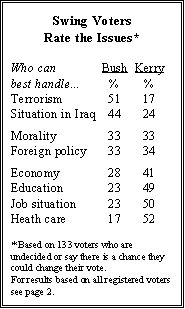 Voters are divided over who can best improve the moral climate of the nation 45% pick Kerry and 41% pick Bush. Issues of morality split sharply along religious lines, with white evangelical Protestants saying by a 63% to 25% margin that Bush can better deal with issues of morality. Non-religious Americans take the opposite view (61% favor Kerry; 22% Bush). White Catholics and non-evangelical Protestants split evenly between the two candidates on morality. Among those who attend church at least weekly, 49% say Bush is better on morality and 37% say Kerry is better.
Voters are divided over who can best improve the moral climate of the nation 45% pick Kerry and 41% pick Bush. Issues of morality split sharply along religious lines, with white evangelical Protestants saying by a 63% to 25% margin that Bush can better deal with issues of morality. Non-religious Americans take the opposite view (61% favor Kerry; 22% Bush). White Catholics and non-evangelical Protestants split evenly between the two candidates on morality. Among those who attend church at least weekly, 49% say Bush is better on morality and 37% say Kerry is better.
Among swing voters, Kerry holds at minimum a two-to-one advantage on education, health care and jobs. But swing voters continue to trust the president far more than Kerry to deal with both Iraq and terrorism. By a 51% to 17% margin, swing voters say Bush can better protect the U.S. from attacks, and nearly twice as many (44% vs. 24%) think Bush has a better plan than Kerry for how to handle the situation in Iraq.
Bush Leads on Character
Despite Kerry’s issue advantage in many areas, voters continue to see Bush as better on a host of personal traits. Majorities continue to say that Bush is more willing to “take a stand” even when unpopular (62% Bush, 29% Kerry); that Bush is a strong leader (57% Bush, 34% Kerry), and that Bush is more likely to use good judgment in a crisis (50% Bush, 38% Kerry). However, two-thirds (68%) also believe that Bush is more stubborn than Kerry (12%). Even Bush’s own supporters say stubbornness is a trait more associated with Bush than Kerry (59% to 16% among those currently favoring Bush’s reelection).
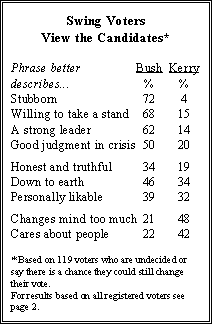 Bush’s leadership advantage is even stronger when the analysis is limited to swing voters. Uncommitteds overwhelmingly rate Bush as more willing to take a stand (68% Bush, 15% Kerry), as a stronger leader (62% Bush, 13% Kerry), and as having better judgment in a crisis (50% Bush, 20% Kerry).
Bush’s leadership advantage is even stronger when the analysis is limited to swing voters. Uncommitteds overwhelmingly rate Bush as more willing to take a stand (68% Bush, 15% Kerry), as a stronger leader (62% Bush, 13% Kerry), and as having better judgment in a crisis (50% Bush, 20% Kerry).
Bush also tops Kerry among all voters, though by narrower margins, on traits such as being personally likable, down to earth, and honest and truthful. These perceptions also hold among swing voters, more of whom see Bush than Kerry as being trustworthy (34% vs 19%, with 27% volunteering that “neither” is honest and truthful). Swing voters also give Bush the edge as being more personally likable and down to earth.
Kerry is seen as a more caring candidate than Bush, although the gap on this measure has narrowed slightly since May. Today, 45% say the phrase “cares about people like me” better describes Kerry and 39% say it better describes Bush. The distribution on this trait in May was 45% Kerry and 34% Bush. Among swing voters, 42% say Kerry is the more caring candidate and 22% say so of Bush.
The Bush campaign portrayal of Kerry as a “flip-flopper” appears to be sticking with voters. Nearly half (47%) say that the phrase “changes his mind too much” better describes Kerry (up slightly from 42% in May), while only 28% say it better describes Bush. These figures are about the same among swing voters (48% Kerry, 21% Bush).

Edwards Most Popular of Candidates
Favorability ratings for Bush have risen since June. Currently, 58% express a favorable opinion of the president while 39% feel unfavorably, an improvement from his 52% to 45% rating two months ago. Despite this modest rise in favorability, Bush has seen no improvement in his job approval ratings over this time period. Today, 46% approve of the job he is doing, while 45% disapprove, virtually unchanged since June.
Kerry, too, has seen his favorability rise somewhat over this time period. Currently, 56% feel favorably toward the Democratic nominee, up from 50% in June. Both Kerry and Bush have enjoyed higher favorability ratings in the past. In February, Kerry 58% felt favorably toward Kerry and just 28% gave him unfavorable marks, and during the major combat phase of the war in April 2003, Bush enjoyed a 72% favorability rating.
About as many Americans give Edwards, Bush and Kerry favorable ratings, but relatively few rate the Democratic vice presidential candidate negatively. Edwards receives ore than twice as many favorable as unfavorable marks (58% to 24%). The percent unable to rate Edwards has fallen to just 18%, from 34% in February.
Democrats overwhelmingly like Edwards (81% favorable, 7% unfavorable), but the vice-presidential candidate’s favorable impression extends across partisan and ideological lines. A small majority of conservatives (52%) give Edwards favorable marks, as do 57% of independents. Even Republicans are divided in their view of the Democratic nominee for vice president, with 40% rating him favorably and 41% unfavorably.
Vice President Cheney’s ratings are much less robust, with 47% of Americans viewing him favorably and 41% unfavorably. These figures represent a sharp decline from the public’s impressions of Cheney at the close of major combat in Iraq in April 2003, when he was viewed favorably by a ratio of better than two-to-one (60% to 27%).
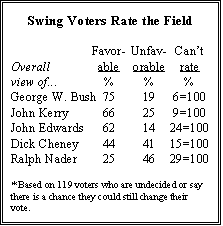 Ralph Nader receives more unfavorable ratings than favorable by a 44% to 26% margin. This is a reversal of his standing four years ago, when a July 2000 Gallup survey found 42% rating him favorably and 22% unfavorably. Today, Democrats are more likely than Republicans (55% vs. 44%) to express an unfavorable opinion of Nader.
Ralph Nader receives more unfavorable ratings than favorable by a 44% to 26% margin. This is a reversal of his standing four years ago, when a July 2000 Gallup survey found 42% rating him favorably and 22% unfavorably. Today, Democrats are more likely than Republicans (55% vs. 44%) to express an unfavorable opinion of Nader.
Swing Voters View the Candidates
Of the four candidates on the major-party tickets, three receive overwhelmingly favorable marks from swing voters. Fully three-quarters rate George W. Bush favorably, and two-thirds say the same about John Kerry. But even here, Dick Cheney stands apart, receiving about the same level of favorable ratings (44%) as unfavorable (41%) ratings from swing voters. Most uncommitted voters also have a negative opinion of Ralph Nader (46%), while just one-in-four view him positively.
Gender Gap in Views of Teresa Heinz Kerry
 Overall, 43% of Americans say they have a favorable view of Teresa Heinz Kerry, while 30% express an unfavorable view and 27% say they can’t give a rating. There is a larger gender gap in views of John Kerry’s wife than for any of the major candidates for office. Women rate her favorably by a 50% to 24% margin, while an equal number of men feel both favorably and unfavorably toward her (37%). This gender gap exists even across party lines, with Republican, Democratic, and independent women giving Teresa Heinz Kerry more favorable ratings than their male counterparts.
Overall, 43% of Americans say they have a favorable view of Teresa Heinz Kerry, while 30% express an unfavorable view and 27% say they can’t give a rating. There is a larger gender gap in views of John Kerry’s wife than for any of the major candidates for office. Women rate her favorably by a 50% to 24% margin, while an equal number of men feel both favorably and unfavorably toward her (37%). This gender gap exists even across party lines, with Republican, Democratic, and independent women giving Teresa Heinz Kerry more favorable ratings than their male counterparts.
But the overall partisan gap in opinions about Mrs. Heinz Kerry is sizable Republicans dislike her by a 51% to 21% margin, while Democrats like her by a 69% to 11% margin. Both independents and swing voters feel more favorably than unfavorably toward her.
Laura Bush, by comparison, is viewed favorably by a sizable majority (70%) of all Americans. Even most Democrats (53%) and committed Kerry supporters (52%) say they have a favorable view of the first lady, and there is virtually no gender gap in opinions about Mrs. Bush.
Age is a driving factor in the favorably ratings of both Laura Bush and Teresa Heinz Kerry. Only 53% of people age 18-29 feel favorably toward the first lady, compared with 76% of those age 30 and older. On the other hand, half of young people rate Mrs. Heinz Kerry favorably, compared with just 44% of their elders.
Convention Interest
 Nearly half (46%) of all Americans say they are interested in following what happens at the Republican Convention in New York later this month, with 27% saying they are very interested. By comparison, in the weeks prior to last month’s Democratic Convention, just 36% said they were interested, 19% very interested.
Nearly half (46%) of all Americans say they are interested in following what happens at the Republican Convention in New York later this month, with 27% saying they are very interested. By comparison, in the weeks prior to last month’s Democratic Convention, just 36% said they were interested, 19% very interested.
Both the conventions’ partisans, as well as the opposition, express more interest in the upcoming convention than the one just past. Nearly two-thirds of Republicans (64%) say they are interested in what happens at their party’s upcoming convention (43% very interested). Barely half (51%) of Democrats had expressed interest in the July Democratic Convention. But more Democrats are interested in the Republican Convention (36%) than vice versa a month ago (26% of Republicans were interested in the Democratic Convention). And in potentially good news for the Republicans’ quest to reach persuadable voters, four-in-ten independents say they are interested in what will happen in New York later this month, compared to only 30% who expressed interest in the Democrats’ Boston event.
Terror Alerts: Most Approve, Some See Political Motives
While a majority (57%) of Americans said that the recent elevation in the terrorism threat level to Code Orange in the financial districts of New York, Northern New Jersey and Washington DC was mostly a genuine effort to warn the public, about a third (34%) said it was done mostly for political purposes.
 In general, most Americans approve of the government issuing terror warnings. Fully two-thirds believe the government should be giving the public all the warnings about possible terrorism that it can even if they turn out to be false alarms, while 28% think the government is putting out too many warnings that turn out to be false alarms.
In general, most Americans approve of the government issuing terror warnings. Fully two-thirds believe the government should be giving the public all the warnings about possible terrorism that it can even if they turn out to be false alarms, while 28% think the government is putting out too many warnings that turn out to be false alarms.
But there are some notable demographic and political divisions on these questions. Younger Americans, secular Americans and Democrats are more likely to think the government is putting out too many false alarms. Half of African-Americans think the latest terror alert was issued mostly for political purposes rather than as a genuine effort to warn the public. Democrats and seculars are also more likely than other Americans to question the motives behind the terror alert.
Attitudes about the terror alerts predictably break along support for the two candidates. People who are committed to vote for Bush strongly believe that the government should provide terror warnings and that the recent alert was genuine. Kerry voters are more skeptical of the terror warnings. Nearly half of Kerry supporters (46%) say the government issues too many warnings that turn out to be false alarms, and 57% say the recent alert was raised mostly for political purposes, not as a genuine effort to warn the public.
Swing voters resemble Bush voters on these issues. Nearly three-fourths (74%) believe the government should warn the public as much as possible, rather than worry about false alarms (18%). Six-in-ten swing voters believe the recent Code Orange was a genuine warning and not an attempt at political manipulation.
Fewer Following Iraq News Closely
 Four-in-ten Americans are following news about Iraq very closely, a level of interest that is comparable to where it was in June and July (39% and 43%, respectively), but substantially lower than public attention earlier in the year, when close to half were following Iraq news very closely. The dropoff in attention to news from Iraq has come across the social and political spectrum. There is no partisan gap in Iraq news interest, and while men, older Americans, and the college educated follow more closely, interest has dropped in all groups about equally.
Four-in-ten Americans are following news about Iraq very closely, a level of interest that is comparable to where it was in June and July (39% and 43%, respectively), but substantially lower than public attention earlier in the year, when close to half were following Iraq news very closely. The dropoff in attention to news from Iraq has come across the social and political spectrum. There is no partisan gap in Iraq news interest, and while men, older Americans, and the college educated follow more closely, interest has dropped in all groups about equally.
The recent Code Orange alert was followed very closely by 34% of Americans, about the same number who paid close attention to previous alerts announced by the Department of Homeland Security. Women especially those over age 50 were more likely than men to follow news about the terrorism warnings very closely. Despite the fact that the alert was limited to three East Coast cities (New York, Newark, N.J., and Washington, DC), there were no regional differences in attention to the story. Also, people in rural areas paid as much attention as did people who live in large cities.
The high price of gasoline at the pumps continues to attract the most public interest, with 52% saying they are following this news story very closely, down slightly from a peak of 58% in June.
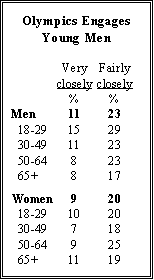 The preparations for the Summer Olympics in Athens have not caught the public’s attention so far only 10% say they followed news about the preparations very closely, while another 22% followed fairly closely. Interest in news about the Olympics is highest among younger men and people from higher socio-economic groups. Fully 44% of men under age 30 are following news about the Olympics at least fairly closely, compared with 32% of older men. About three-in-ten women of all age groups are following this story. College graduates and people earning $75,000 or more annually express more interest than do others.
The preparations for the Summer Olympics in Athens have not caught the public’s attention so far only 10% say they followed news about the preparations very closely, while another 22% followed fairly closely. Interest in news about the Olympics is highest among younger men and people from higher socio-economic groups. Fully 44% of men under age 30 are following news about the Olympics at least fairly closely, compared with 32% of older men. About three-in-ten women of all age groups are following this story. College graduates and people earning $75,000 or more annually express more interest than do others.
Americans continue to express relatively high levels of interest in the presidential campaign currently a third say they are following news about the candidates very closely, up slightly from an already high 29% in July. By comparison, only 22% were following campaign news very closely in September 2000, and 24% in September 1996.


